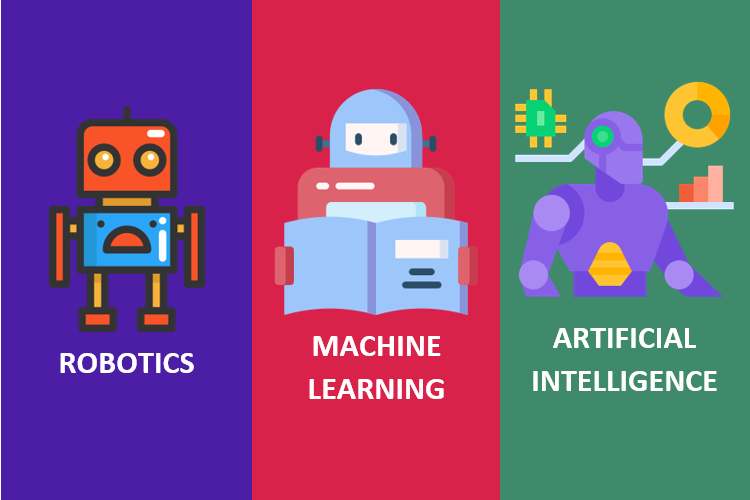Introduction
Especially robotics, artificial intelligence and machine learning that have registered considerable technological advancement and public awareness. Nevertheless, these terms are used rather loosely or interchangeably. It is therefore important to know how they differ from each other.
In this article we will discuss each of these fields in turn, describe their interdependence, and identify the primary distinctions between robotics, AI and ML.

Robotics
Robotics can be understood as the science and application of robots – mechanical, electronic, programmable or computer-controlled devices for performing operations automatically. Robotics combines mechanical and electrical technologies, computer sciences and others, in order to create robots and systems, control and use them.
A robot typically consists of:
- Hardware: Mechanical components like motors, actuators, sensors, and a physical body.
- Software: Programs that control the robot’s behavior and interactions with its environment.
- Sensors: Devices that gather information about the robot’s surroundings, such as cameras, microphones, and touch sensors.
- Actuators: Mechanisms that allow the robot to perform physical actions, like moving limbs or manipulating objects.
Robots may have different designs, but all of them have those main components. These can include industrial workhorses where the applications are well understood and defined all the way to consumer products to cutting edge research pieces that are at the bleeding edge of what has been designed and built. Today’s robots have computational processors for perception, planning, control and learning implicit in the operation of the robots.
Artificial Intelligence
Artificial intelligence in general denotes computers that display human cognition. This can include capabilities such as reasoning, learning, perception, problem solving, planning, creativity and etc.
Science of AI aims at making machines intelligent at par with human beings such that they are capable of such human mental activities such as seeing, listening, thinking, speaking, naturally understanding language, expressing ideas creatively, and apply knowledge to achieve objectives in a variety of disciplines.
AI can be broadly categorized into:
- Narrow AI: Designed to perform specific tasks, such as playing chess or recognizing faces.
- General AI: Capable of understanding and learning any intellectual task that a human can.
- Superintelligence: Exceeding human intelligence in all aspects.
AI techniques encompass a wide range of methods, including:
- Search algorithms: Used to find solutions to problems by exploring different possibilities.
- Knowledge representation: Methods for representing information and relationships between concepts.
- Machine learning: Algorithms that allow systems to learn from data and improve their performance over time.
This is the case because the difference between narrow AI and artificial general intelligence—the ability of machines to reason and solve problems in many cognitive domains—remains far. But while the narrow conception of AI has been presented, the definition of AI has in fact been deployed uniformly. AI principles are at the heart of a good deal of today’s computing.
Machine Learning
Machine learning can be said to fall under artificial intelligence. It refers to the creation of systems that can learn, alter their behavior patterns based on real world experience, self-enhance their knowledge or performance of tasks, and do all this without specific directions.
One of the strengths of machine learning is the capability to find patterns in a data set so that a mathematical model can be trained to make a forecast or implement a choice without prior defined models being trained by humans. Like any machine, their performance indices change with time or amount of experience or data exposed to.
There are three main types of machine learning:
- Supervised learning: Involves training models on labeled data, where the correct output is provided for each input.
- Unsupervised learning: Involves training models on unlabeled data, where the model must discover patterns and relationships on its own.
- Reinforcement learning: Involves training models to make decisions based on rewards and punishments.
Machine learning algorithms include:
- Linear regression: Used for predicting numerical values.
- Decision trees: Used for making classification and regression decisions.
- Neural networks: Inspired by the human brain, neural networks are capable of complex pattern recognition and learning.
There are three main types of machine learning: The three types of Artificial Intelligence are: Supervised learning, where models are trained using input-output examples to make prediction, unsupervised learning where patterns in the data are discovered to make predictions, and reinforcement learning where models learn to make actions based on the values provided.
Relationship between Robotics and AI/ML
Robotics for his part is more involved with the construction of physical entities, more known as mechanical people, fitted with talents to recall, bear in mind, and give a response to real physical situations. AI supplies much of brains – the intelligence, the decision-making ability, the thinking ability that allows robots to function rationally. And then machine learning brings the inkling of what methods a robot can use to enhance its own abilities independently using the experiences gathered without direction from the programmer.
That is why AI provides most of the actual information processing that endows robots with high intelligence. Computing on the other hand merges AI into physical systems in view of creating functional active organisms or interaction interfaces designed act intelligent. while machine learning empowers robotic systems to actually enhance real-word competence and choice making capabilities—thus pulling them towards Artificial General Intelligence [AGI].
To robots, machine learning provides the benefit that they can learn without being spelled out what to do every step of the way. Thus, with increased exposure, there becomes more information which can be fed into ML models and help in developing sophisticated mitigation /adaptation measures.
Key Differences
Understanding differences between robotics, AI, and machine learning is important:
| Feature | Robotics | Artificial Intelligence (AI) | Machine Learning (ML) |
|---|---|---|---|
| Focus | Physical interactions and actions | Intelligent behavior and problem-solving | Learning from data and improving performance |
| Components | Hardware (mechanical, electrical, sensors, actuators), software | Algorithms, knowledge representation, reasoning | Algorithms, data, models |
| Applications | Manufacturing, healthcare, exploration, service industry | Natural language processing, computer vision, game playing, decision-making | Recommendation systems, fraud detection, medical diagnosis, image recognition |
| Relationship | Robotics often incorporates AI and ML | AI encompasses ML and other techniques | ML is a subset of AI |
| Key Concepts | Sensors, actuators, control systems | Reasoning, learning, problem-solving | Algorithms, data, training |
| Examples | Industrial robots, surgical robots, autonomous vehicles | AI-powered chatbots, self-driving cars, intelligent assistants | Recommendation systems, facial recognition, fraud detection |
Scope and Functionality
One of the fundamental differences between robotics, AI, and ML lies in their scope and functionality.
Robotics focuses on the physical aspect of creating machines that can perform tasks in the real world. It involves hardware design, sensors, and actuators that enable robots to interact with their environment.
Artificial Intelligence, on the other hand, concentrates on implementing intelligent behaviors in machines. It emphasizes the development of algorithms that allow machines to process information, learn from experiences, and make decisions. AI is less concerned with the physical embodiment of machines and more focused on cognitive capabilities.
Machine Learning is a specialized area within AI that specifically deals with the learning process. It provides the tools and techniques for machines to improve their performance based on data. While AI encompasses broader concepts of intelligence, ML is the means through which that intelligence is often realized.
Interdependence
Despite their differences, robotics, AI, and ML are interdependent fields that often work together to create advanced systems.
Robotics can benefit significantly from AI by incorporating intelligent algorithms that enable robots to adapt and improve their performance in real-time. For instance, a robotic arm used in manufacturing can utilize AI-driven computer vision to detect defects in products and make adjustments accordingly.
Machine Learning plays a critical role within AI by providing the necessary tools for data analysis and pattern recognition. For example, in autonomous vehicles, ML algorithms analyze data from sensors and cameras to make real-time decisions about navigation and obstacle avoidance. This integration allows robots to operate in complex and dynamic environments.
Overlap and Integration
Despite their differences, these fields often overlap and complement each other. For example, AI-powered robots can use machine learning algorithms to improve their decision-making and adapt to new situations. Similarly, ML models can be deployed on robotic platforms to enable autonomous behavior.
Conclusion
Robotics, AI, and ML are driving technological advancements across various industries. By understanding their unique characteristics and how they interact, we can appreciate their potential to shape our future. As these fields continue to evolve, we can expect even more exciting and innovative applications to emerge.


